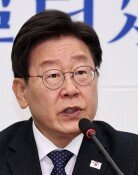Concrete measures needed to counter N.K.’s nuclear missiles
Concrete measures needed to counter N.K.’s nuclear missiles
Posted February. 14, 2017 07:07,
Updated February. 14, 2017 07:14
As to the ballistic missile launched by North Korea on Sunday, Pyongyang announced that the missile was “Bukgeukseong-2," a ground-to-ground mid-and long-range strategic ballistic missile as part of the new strategic weapon system. In other words, the North is claiming that the projectile is a new type of solid-fueled strategic ground-to-ground missile built on the SLBM system. While liquid-fueled engines need refueling before launch, which makes it possible for the projectiles to be detected by satellites, solid-fuel engines can be even more fatal as they allow for covert launch of missiles.
The South Korean military said on Sunday morning that the North Korean missile was a “Rodong-grade,” and later in the afternoon called it a “revised Musudan missile.” Only after Pyongyang made the announcement on Monday, did the military admit that it was an Intermediate-Range Ballistic Missile (IRBM). It is concerning when the military even cannot identify the missile launched by its closest neighbor while it should be capable of protecting the life and property of South Koreans.
It is reported that North Korean leader Kim Jong Un was satisfied with the “creation of yet another powerful nuclear weapon.” It is quite unusual that the launch was conducted to raise the blast angle for higher altitude instead of boosting striking range. The North Korean missile blasted on Sunday travelled about 500 kilometers, but if the angle had been lowered, it would have flown 2,000 or 3,000 kilometers, all the way down to mainland Japan and the U.S. military base in Okinawa.
If the North fires the missiles at such a high angle, the descending velocity of the warhead will reach Mach 10, far surpassing the interception capacity of the Korean Air and Missile Defense (KAMD), which is designed to catch up with Mach 4 or 5. The military explains that the THAAD system can intercept missiles with Mach 8 in velocity in the altitudes between 40 kilometers and 150 kilometers, and that it can even neutralize missiles flying as fast as at Mach 14 if they travel head-on, but concerns still remain.
Facing the first provocation from the North since inauguration, President Trump is making composed responses, instead of playing hardball as expected. During a press conference with Prime Minister Abe, President Trump said, he “supports Japan 100%”, but he did not make any comment about defending South Korea. It is worrying if Kim Jong Un might misinterpret Trump’s response. South Korea needs to find a self-rescue measure quickly by implementing the THAAD system earlier than scheduled, instead of relying on the U.S. troops.
Protecting the people from the ever-sophisticated nuclear weapons and missiles of North Korea will be top priority in the to-do list of South Korea’s next president. Rep. Moon Jae-in, former chairman of the Minjoo Party of Korea who is leading the polls among many other presidential candidates, said the implementation of THAAD must be postponed to the next administration, and raised questions about the General Security of Military Information Agreement (GSOMIA) between South Korea and Japan when South Korea needs security allies more desperately than ever. It is crucial that presidential candidates from the main and opposition parties provide detailed plans to counter North Korean missile threats before voters cast their ballots. If one were to stress the virtue of dialogues with Pyongyang when the regime is holding a nuclear knife to our jugular, he or she will need to elaborate on how doing so is not tantamount to recognizing Pyongyang as a nuclear state and succumbing to the demands of Kim Jong Un.







